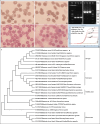Babesia microti (Babesiidae, Piroplasmida) infection in a Chinese traveler returning from the United States of America
- PMID: 40490844
- PMCID: PMC12150541
- DOI: 10.1186/s40249-025-01311-x
Babesia microti (Babesiidae, Piroplasmida) infection in a Chinese traveler returning from the United States of America
Abstract
Background: Human babesiosis, caused by intraerythrocytic protozoa of the genus Babesia (Piroplasmida, Babesiidae), is a globally emerging zoonosis transmitted primarily through Ixodes spp. ticks. Babesia microti, which is endemic particularly in the northeastern and midwestern United States, accounts for the majority of globally reported human cases. Recent studies highlight its spread to non-traditional regions and cross-border transmission, driven by climate change, blood transfusions and increased human mobility. Despite increasing reports of autochthonous B. microti infections in certain areas of China, imported cases remain critically underrecognized due to overlapping clinical manifestations with malaria and limited diagnostic awareness.
Case presentation: We report a diagnostically challenging case of acute B. microti infection in a 52-year-old Chinese woman, presenting with a sudden recurrent fever (39.0-41.0 °C), hemolytic anemia (hemoglobin 104 g/L), thrombocytopenia (platelet 78 × 109 /L) and splenic hypodense lesions on July 11, 2023, seven days after returning from a 14-day visit to rural Wisconsin, United States. Peripheral blood smears demonstrated characteristic intraerythrocytic ring forms (parasitemia: 7800 organisms/μl) and pathognomonic "Maltese cross" tetrads. Polymerase chain reaction (PCR) targeting the 18S rRNA gene confirmed B. microti infection (GenBank No. PP087232), showing 99.8% identity with the US-type strain Gray (AY693840) and the sequence obtained from a US travel-acquired case in Singapore (MK609547). The patient received intravenous clindamycin (600 mg twice daily), oral dihydroartemisinin (80 mg twice daily), packed red blood cell transfusions, and supportive care, ultimately achieving full recovery after 17 days.
Conclusions: This study documented the first imported cases of human babesiosis in China, emphasizing the need for heightened clinical and public health vigilance. Screening travelers from endemic areas presenting with fever or hemolytic anemia for Babesia, bolstering molecular diagnosis, improving transfusion safety, and intensifying regional surveillance are crucial in reducing underdiagnosis and preventing transmission. These measures are essential for controlling babesiosis in China.
Keywords: Babesia microti; Hemophagocytosis; Human babesiosis; Travel-related diseases.
© 2025. The Author(s).
Conflict of interest statement
Declarations. Ethics approval and consent to participate: The study protocol was approval by the Ethics Committee of Beijing Friendship Hospital, Capital Medical University for Human Research (Beijing, China) with the number 2023-P2-358. The participant was provided with information regarding the study and gave their written informed consent prior to participation. Consent for publication: Written informed consent was obtained from the patient for publication of this case report. Competing interests: The authors declare that they have no competing interests.
Figures

Similar articles
-
Ixodes persulcatus Ticks as Vectors for the Babesia microti U.S. Lineage in Japan.Appl Environ Microbiol. 2016 Oct 27;82(22):6624-6632. doi: 10.1128/AEM.02373-16. Print 2016 Nov 15. Appl Environ Microbiol. 2016. PMID: 27590815 Free PMC article.
-
A fatal case of transfusion-transmitted babesiosis in the State of Delaware.Transfusion. 2009 Dec;49(12):2583-7. doi: 10.1111/j.1537-2995.2009.02454.x. Epub 2009 Nov 9. Transfusion. 2009. PMID: 19906041
-
Quantitative PCR for detection of Babesia microti in Ixodes scapularis ticks and in human blood.Vector Borne Zoonotic Dis. 2013 Nov;13(11):784-90. doi: 10.1089/vbz.2011.0935. Epub 2013 Oct 9. Vector Borne Zoonotic Dis. 2013. PMID: 24107203 Free PMC article.
-
Splenic Rupture as the First Manifestation of Babesia Microti Infection: Report of a Case and Review of Literature.Am J Case Rep. 2018 Mar 23;19:335-341. doi: 10.12659/ajcr.908453. Am J Case Rep. 2018. PMID: 29567936 Free PMC article. Review.
-
Transfusion-transmitted Babesia spp.: bull's-eye on Babesia microti.Clin Microbiol Rev. 2011 Jan;24(1):14-28. doi: 10.1128/CMR.00022-10. Clin Microbiol Rev. 2011. PMID: 21233506 Free PMC article. Review.
References
-
- Waked R, Krause PJ. Human babesiosis. Infect Dis Clin North Am. 2022;36(3):655–70. - PubMed
-
- Vannier E, Krause PJ. Human babesiosis. N Engl J Med. 2012;366(25):2397–407. - PubMed
-
- Jia N, Zheng YC, Jiang JF, Jiang RR, Jiang BG, Wei R, et al. Human babesiosis caused by a babesia crassa-like pathogen: a case series. Clin Infect Dis. 2018;67(7):1110–9. - PubMed
-
- Krause PJ. Human babesiosis. Int J Parasitol. 2019;49(2):165–74. - PubMed
-
- Surveillance for babesiosis-United States. https://www.cdc.gov/parasites/babesiosis/data-statistics/index.html/ Accessed 21 May 2024.
Publication types
MeSH terms
Supplementary concepts
Grants and funding
LinkOut - more resources
Full Text Sources
Miscellaneous

